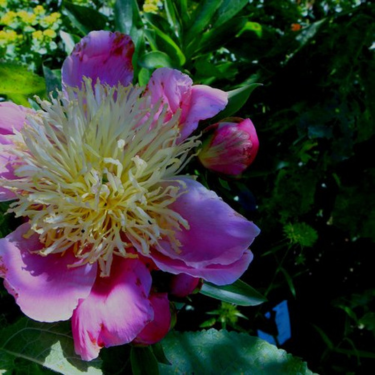The Cats of La Romieu, A Feline Haven in France
At Feline Fancy, we love exploring places anything Feline related. In France there is a Village known as - The Cats of La Romieu in the southwestern Département of Gers.
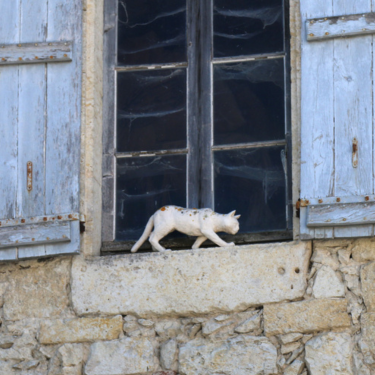
Despite being a small village with around 500 residents, La Romieu is renowned for its strategic location on the Voie Podiensis, a key pilgrim route of the Camino de Santiago. The village is dominated by a magnificent 14th century Collegiale church, which we were eager to visit. However, what truly excited us was uncovering the legendary story of the cats of La Romieu.
La Romieu - A Village of Cats
Stand in the heart of the medieval bastide village of La Romieu, and you'll spot several cats. As you stroll around, you'll encounter many more, basking on window ledges, climbing through holes, or nosing around in bushes.
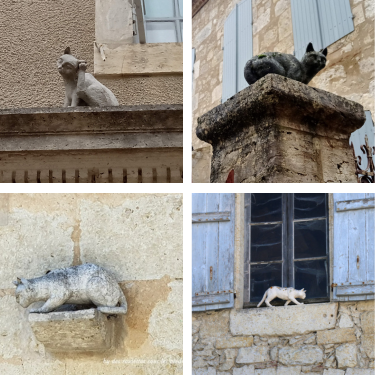
Original La Romieu Cats.
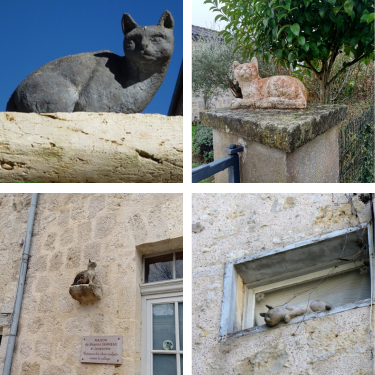
Continue reading to uncover the story behind these cats and their significance. We'll also guide you through other highlights of La Romieu, including the Collegiale church and the Jardins de Coursiana, recognized as a "Jardin Remarquable" by the French Minister of Culture in 2005.
La Romieu - History and Location
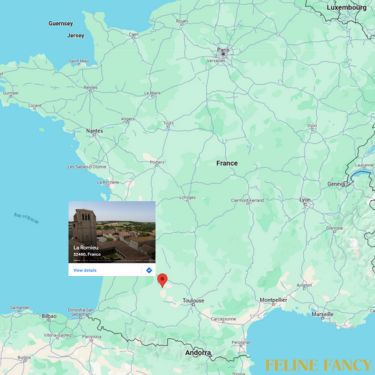
La Romieu, a beautiful village in France, is positioned in the northern region of the Gers Département, approximately 650 miles (1,041km) away from Calais. The area is predominantly rural, with agriculture serving as the primary economic activity. While there are some vineyards, the region is renowned for its arable crops and fruit cultivation, notably the world famous Pruneaux d'Agen (Agen being roughly 20 miles from La Romieu).
Nestled on one of the principal pilgrimage routes to Santiago de Compostela in Spain, La Romieu traces its origins back to 1082 when two monks from Rome halted there and decided to establish a priory, a refuge, and a hospital. Referred to by the Gascon locals as "Roumious," meaning "the pilgrims from Rome," this nickname bestowed upon the settlement its eventual name.
Benefiting from its strategic location and status, La Romieu prospered, culminating in the construction of the impressive Collegiale of St Peter in the 14th Century. This grand ecclesiastical structure stands prominently at the heart of La Romieu. While some sections still date back to the 14th Century, the remainder underwent reconstruction following damage incurred during periods of Protestant control in the 16th Century and after the French Revolution in 1789.
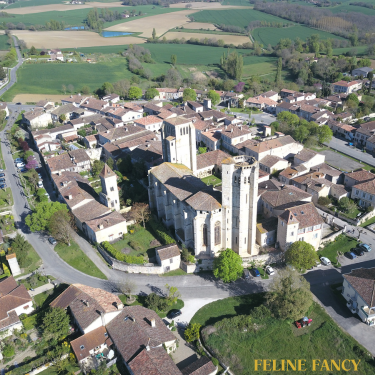
Notably, La Romieu is also renowned for its Angeline cat, a cat sculpture by Maurice Serreau, adding to its allure as a tourist attraction. Visitors are captivated by the village's charming ambiance and its endearing village cats, making it a must-visit destination for cat lovers and history enthusiasts alike. In fact, many villagers proudly consider themselves as adoptive parents to these beloved felines, who roam the streets and even have their own "cat attic" in the Collegiale of St Peter, a testament to the deep-rooted love for cats in La Romieu.
The Collegiale of St Peter dominates the landscape.
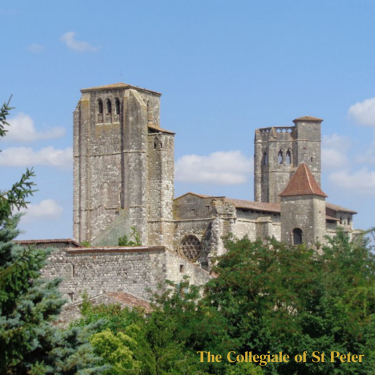
The Legend of the Cats
Dating back to around 1342, a medieval legend emerged, just two decades after the completion of the Collegiale, recounting a tale of a beautiful village in France beset by famine due to three consecutive years of poor harvests. The dire situation led villagers to resort to slaughtering domestic animals for sustenance, including cats. Amidst this hardship, a young orphan girl named Angeline harbored a deep affection for the village cats and could not bear the thought of their demise. With the permission of her guardian, she clandestinely sheltered a male and a female cat in their barn.
As time elapsed and the weather gradually improved, the villagers' hopes for salvation were met with apprehension as they realized that other creatures, particularly rats, were poised to ravage the maturing harvest. With no feline presence left in the village, the rat population thrived to the dismay of the villagers. It was then that Angeline disclosed her secret to the community. To their delight, they discovered that Angeline was not only harboring a pair of cats but a total of 20 felines eager to lend their aid in the fields!
In no time, the rodent population was brought under control, and life in the village resumed its normal rhythm. Angeline's profound love for cats had effectively rescued the village from the brink of starvation! Additionally, La Romieu is renowned for its Angeline cat, a cat sculpture by Maurice Serreau, making it a captivating tourist attraction. Many villagers proudly consider themselves as adoptive parents to these beloved felines, who roam the streets and even have their own "cat attic" in the Collegiale of St Peter, showcasing the enduring love for cats in La Romieu.
The complete official rendition of the Legend
The Modern Retelling of the Legend.
Maurice Serreau, an artist who had retired to the beautiful village of La Romieu in France with his wife, Jacqueline, was familiar with the legend. As a tribute to it, he began sculpting cats for his own residence and those of acquaintances in the village. Over the span of a few years, Serreau crafted 14 stone cats, adorning buildings in the heart of La Romieu. This act served as a poignant commemoration of the medieval legend and a homage to the practical and emotional significance that cats hold in human lives, both commercially and domestically.
The legend, set in the middle ages, tells the tale of Angeline a cat women, a young girl who saved her village from famine by hiding a male and a female cat in their barn. As the weather improved, the cats multiplied, controlling the rodent population and restoring prosperity to the village. La Romieu, with its charming medieval architecture and renowned Collegiate Church of Saint Jacques, is not only a picturesque destination but also a UNESCO World Heritage site. Serreau's cat sculptures, known as the "Romieu cats," have become an iconic symbol of the village, attracting visitors on road trips and pilgrimages alike who are eager to see these whimsical creations that pay homage to the enduring bond between humans and felines.
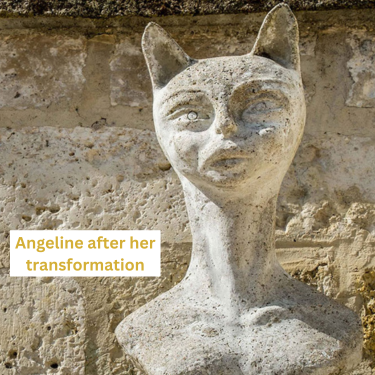
Among Maurice Serreau's collection of 14 sculptures stands one of Angeline, the girl whose affection for cats rescued the village. According to legend, as Angeline matured, she gradually acquired feline characteristics, such as pointed ears. Serreau's depiction of her in bust form certainly reflects this aspect of the tale.
One of the Plus Beaux Villages de France.
The village initially developed in a rather haphazard manner as people came to settle near the renowned hermit, in the fourteenth century the village's layout was transformed entirely when many of the original houses were demolished to make way for a palace and the imposing Collégiale Saint-Pierre, built between 1312 and 1318.
This transformation was commissioned by Arnaud d’Aux de Lescout, a native of La Romieu who became a Cardinal to Clément V, the first Pope to settle in Avignon. It must have been surreal for the villagers to witness these enormous structures rising in their small village. I imagine it felt like the arrival of a spaceship to them. Today, only one tower remains from the Palace, but Saint-Pierre, with its cloisters and church featuring two towers. One of which contains magnificent medieval paintings in ochre, yellows, reds, and blacks.
Guided tours of La Romieu, classified as one of the Plus Beaux Villages de France, are organized by the tourist office, and the Collégiale Saint-Pierre is open to visitors year round.
La Romieu in 2024
In the present day, the cats of La Romieu serve as a notable tourist draw, contributing to the vibrancy and prosperity of the village.
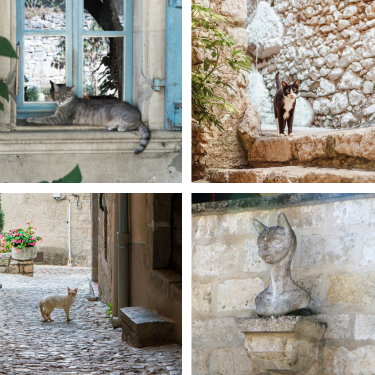
Despite its modest size, the charming Village France boasts an impressive array of restaurants and accommodations that cater to a variety of tastes and preferences. Among these, L'Etape d'Angeline stands out, not only for its delightful offerings but also because it is named after the heroine of a beloved local story. This enchanting establishment, located in the central square of Romieu village, a picturesque part of the Villages de France, is also home to the majority of the village's famous cat sculptures.
These sculptures, created by the talented Sculptor Maurice, can often be found perched on a window sill or carved in stone, adding a whimsical touch to the village. Visitors can enjoy a meal or stay the night at L'Etape d'Angeline while immersing themselves in the unique cultural and artistic atmosphere. With the cat-themed elements like Cat Ear, Cat Soon, and Cat Find intricately woven into the village's fabric, the charm of De La Romieu is undeniable.
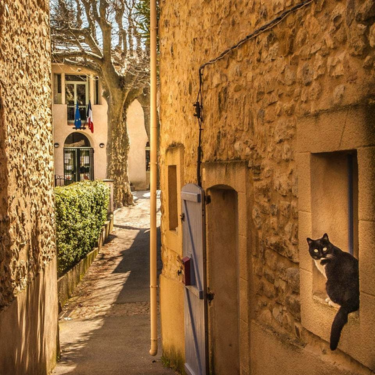
The Collegiale of St Peter
You will have a fantastic time visiting the UNESCO World Heritage-listed Collegiale of St. Peter. Renting a headset with commentary for an additional 1 Euro on top of the ticket price is definitely worth it. Here are a few more snapshots
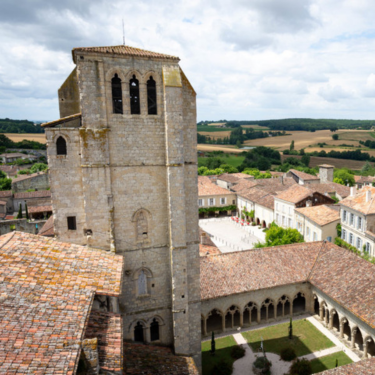
The Collegiale features two towers, one of which houses an exceptionally rare double helix stone staircase. The most renowned staircase of this kind from the same era can be found at the Chateau de Chambord in the Loire Valley. Constructed during a time when religious persecution was a constant threat, this second "secret" staircase provided the Collegiale's occupants with a means to hide or escape from their enemies.
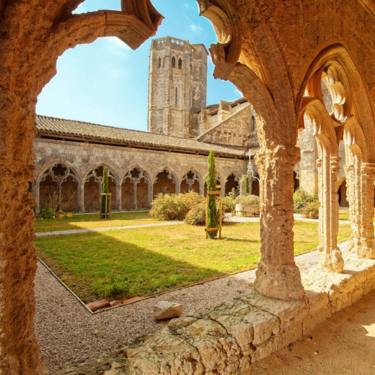
The cloisters were stunning, offering a tranquil haven and a cool refuge on a hot day.
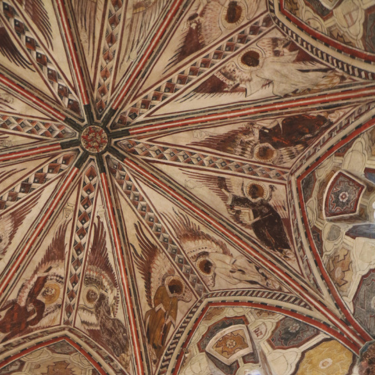
Amazing painting medieval paintings in ochre, yellows, reds, and blacks on the ceiling, truly a special place.
The Jardins de Coursiana
The Collegiale of La Romieu, as viewed from the Jardins de Coursiana.
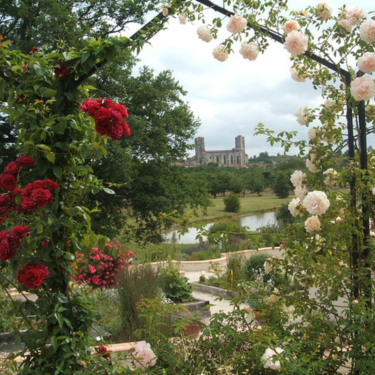
Situated approximately 850 meters from the center of La Romieu, the Jardins de Coursiana were established in 1974 by a distinguished French botanist, initially as an arboretum. Over the years, the gardens have expanded to include nationally recognized plant collections, featuring an English garden, a vegetable garden, and a garden of aromatic and medicinal plants. Altogether, the gardens boast over 750 species of trees and shrubs, some of which are over 200 years old.
